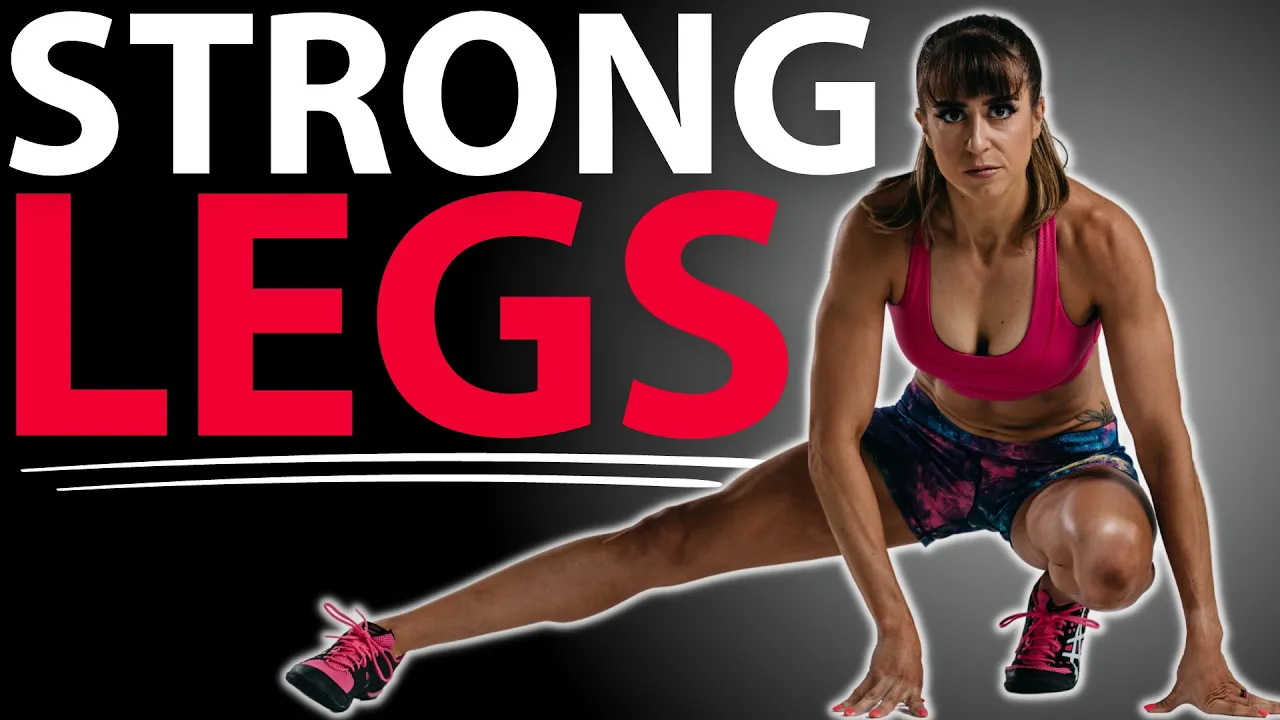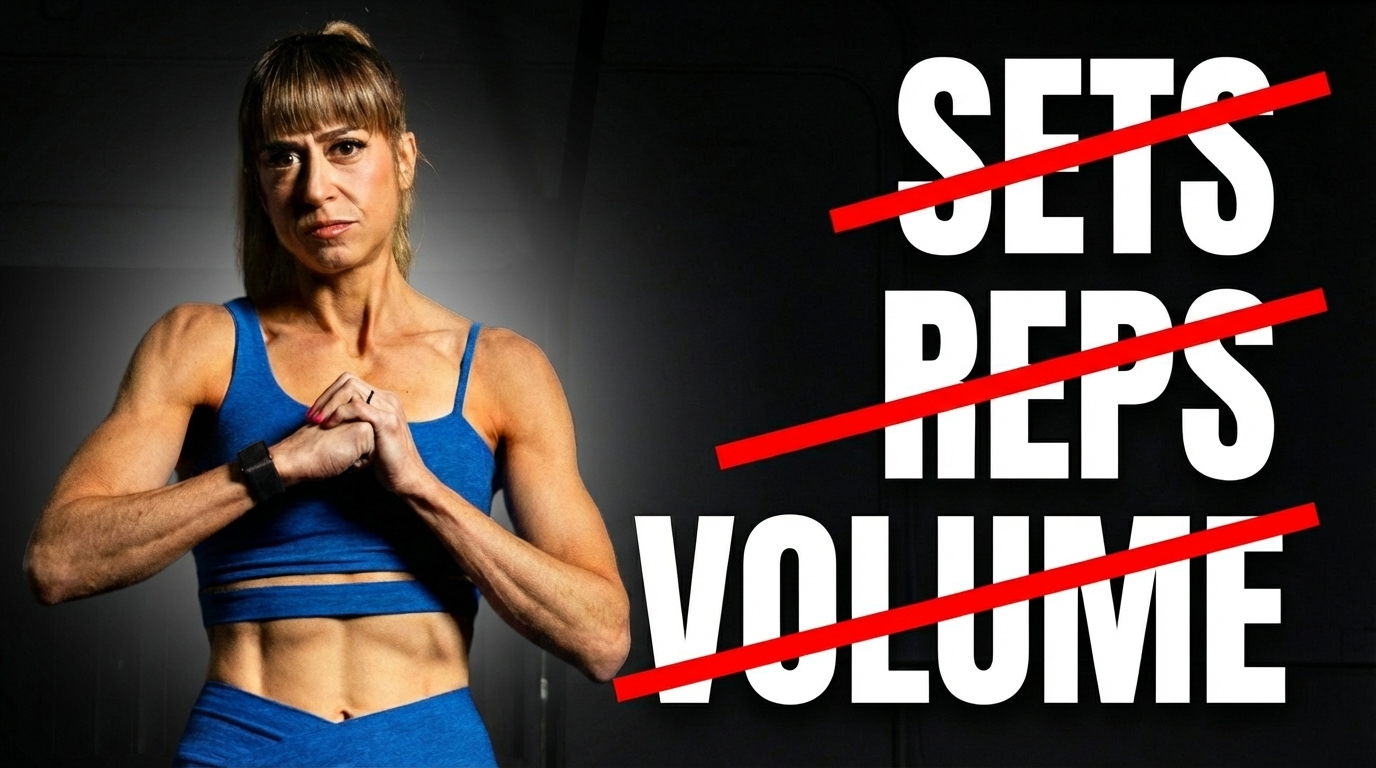Looking for some amazing leg exercises to take your training to the next level?
Then you’ll love these 8 lower body exercises I’ll share in this video!
These moves take those fundamental movements and add a little twist to the basics to help you progress through not just adding loads but also different types of tension, different loading placements, different bases of support and even different ranges of motion.
There are so many ways to vary moves to match our specific needs and goals. With these tweaks you can even impact how much you are using specific muscles involved.
And it’s key we find different ways to progress, especially the longer we’ve been training!

Hey guys, it’s Cori from Redefining Strength where we help you feel, look and move your best at any and every age.
While we are never above the basics, and should always return to them, we can make little tweaks to movements to keep our training fresh and interesting while creating progression in new and different ways.
Especially the longer we’ve been training, the more we have to explore different options to create that progression and drive muscle growth.
These movement variations can also be fun as we get older to not just beat our bodies up by trying to force heavier loads or even to help us when we’ve hit a stickpoint with the weights we can move during a specific movement.
That’s why I wanted to share 8 amazing lower body exercises that create progression in different ways!
Move #1: Cable Step Up
Step ups are a great unilateral leg exercise to help you strengthen each side independently to correct imbalances.
And while they work your entire leg, you can make them more glute intensive by changing how you load them down.
By using a cable anchored down low to apply resistance to the movement, you can emphasize the resistance on the drive up, helping you to even better activate that glute on your working side.
Hold a cable in one hand on the same side as the foot you’ve put on the bench. Focus on that push through that foot on the bench to drive up to standing as if a string was pulling you up by your head.
That focus on the drive with the resistance of the cable will make you feel that glute working even more!
To modify this move, lower the bench or box.
To make it even more glute intensive, use a higher box and even start on top only lowering down till your toe grazes the ground!
Move #2: Staggered Stance Squat
Squats are an important movement pattern to train. The more you learn to control that squatting movement, the more you can keep your knees and hips healthy and happy!
The Staggered Stance Squat variation puts an emphasis on each side independently without creating as much instability as a full single leg or pistol squat.
Because your feet are staggered with your back foot back at the instep of your front foot and the heel raised, you are making one side work harder while also reducing the impact that your ankle mobility can have on your squat depth.
Limited ankle dorsiflexion, or the ability to draw our toes up toward our shins, can lead to us not being able to squat as deep AND even putting more stress and strain on our knees as all of our weight shifts forward during a squat.
So this variation may be the tweak you need!
Just make sure you are lifting the heel of the foot staggered back and focusing your weight on that fully planted leg.
Do not stagger the foot too far back though and turn this into more of a lunge.
You can progress this move by adding weights, even making it more core intensive by holding a dumbbell or kettlebell for a goblet squat, or you can modify this move by limiting the range of motion and sitting down to a bench or box.
Move #3: Double Banded Hip Thrusters
Hip Thrusters are a must-do move if you want to build strong glutes.
But the barbell can be difficult to work with at times.
And sometimes you want a variation more meant to be that accessory exercises after your lift to create that pump and burn while targeting your glute medius more.
That’s the beauty of the double banded hip thrusters.
Not only will this move work your glute max, but the mini band around your legs will also really target your glute medius to improve your hip stability.
The band over your hips, which is easiest to anchor off of j-hooks in a rig or squat rack, applies even more resistance as well at the top of the movement when your glutes are the strongest.
Just make sure you really drive out against the mini band as you drive up against the resistance band. You want to fully extend your hips, while maintaining a posterior pelvic tilt to better engage your glutes and prevent yourself from arching your lower back and compensating.
Move #4: Deficit Split Squat
Changing up the range of motion of a movement can impact the benefit we get from it.
We can limit the range of motion to spend more time under tension or we can increase the range of motion to increase the challenge while also helping to improve our mobility and stability.
With the Deficit Split Squat, you are increasing the range of motion to help you strengthen your quads, hamstrings and glutes, but also improve your hip flexibility and mobility.
This is also a great way to vary up the Bulgarian Split Squat or Balance Lunge we often turn to, putting the emphasis on lifting up that front foot to increase the range of motion we move through.
Just make sure you actually lower all the way down using that full range of motion.
If you lift your front foot up but do not lunge any deeper, you aren’t getting the extra benefit of the range of motion.
To advance this move, you can not only increase the height of what you’re standing on but also add loads.
And if you are just starting out, you can actually LIMIT the range of motion of the split squat as well to learn to control it by placing a block under your knee to help you learn to control the range of motion you have currently.
Move #5: Landmine Band Deadlift
Deadlifts, or a hip hinge of some form, should be included in almost everyone’s workout routine at some point.
While deadlifts so often get demonized for causing lower back pain, learning to control the hip hinge properly can actually help you AVOID lower back issues as you get older.
They are an amazing exercise to build that posterior chain and strengthen your glutes and hamstrings.
You can further target these muscles, and even force yourself to slow down the movement, while progressing it, by using two types of resistance – both bands and a barbell – like in the Landmine Band Deadlift.
The fixed anchor of the barbell can also be helpful as it prevents the weights from drifting forward and away from your body like they can in a traditional deadlift which is also what can lead to lower back overload.
The band applies more tension at the top of the deadlift to work the glutes even more and forces you to slow down the eccentric portion of the movement, or the lowering down of the deadlift to really work those hamstrings.
This is a great variation to improve your muscle hypertrophy without you trying to force a heavier load you aren’t yet ready to include.
And if you don’t have a landmine, you implement two types of resistances using dumbbells instead!
Move #6: Bench Supported Single Leg Deadlift
While many of us don’t like the awkwardness of balance moves, like the single leg deadlift, especially because we can’t use as heavy a weight, they are key to include.
Working on that mind-body connection to improve our balance is key to help us avoid injury as we get older. And unilateral moves also help us correct imbalances and improve our core stability.
However, if you are finding you’re not yet ready for the full balance challenge of the single leg deadlift, or you want to mix up your unilateral deadlift work while using heavier loads, you can do a bench supported variation.
This variation takes out some of the stability demands which may allow you to even better activate the hamstring of the standing leg.
With this move, you will put your knee of your lifted leg back on a bench. You can then press down into this knee slightly as you hinge over, pushing your butt back. But you want to focus on really creating that tension through that standing leg.
Press that standing foot down firmly into the ground and push the ground away as you drive back up to standing. If you add weights, lower the weights back toward your instep to protect your lower back and really help yourself sit your butt back as you hinge over.
Move #7: Band Lean Backs
While this move may not be right for you if you have knee issues limiting your ability to knee or control knee flexion, this move is often demonized by those with knee pain when it can actually be a key component of rehab for some.
Because you’re also working your quads while in hip extension, this is also a great way to target the rectus femoris more than during a normal leg extension movement.
And the band creates a great way to progress the basic bodyweight lean back and applies resistance in a different way than just holding a dumbbell up at your chest does.
The band forces you to really control the eccentric portion of the move, or the lean back, and then applies more resistance on your quads as you drive back up to kneeling tall as the band stretches.
It makes your quads really work through the full range of motion!
The band can also be used to modify the movement if you face the anchor point as it will add assistance to help you control the lean back.
Just really make sure you are moving at your knees to lean back and not just arching your lower back.
Even focus on that glute engagement through the movement to keep your hips extended.
And if you really can’t kneel, you can still do quad flexes lying on a bench to get the benefits of a hip extended position to target that rectus femoris.
Move #8: Airborne Lunge
Even without weights or equipment we can create workouts that challenge us.
One great way to do this is by creating less of a base of support and more instability in a movement.
With the Airborne Lunge you are creating that instability by using only a single leg for support to balance and even making the basic lunge more challenging because of the range of motion you can perform with this movement.
This lunge can be a great way to build up toward that full pistol squat while targeting your glutes a bit more because it is more of a hip hinge movement.
When you do this exercise, you will hinge at the hips as you bend your knees to drop that back knee to touch the ground. You do not want to touch that back foot down. Just lightly touch your knee. Make sure your front heel stays down as you touch the ground.
You can then make this move even more challenging by changing up the tempo and including a slower lower down or even a pause at the bottom.
To modify it, you can hold onto something in front of you or even place a block beneath your back knee to limit the range of motion you have to control to start!
Every move we include should have a purpose and be based on our needs and goals. There is no one right exercise. No one best move.
There are so many ways to create variations that fit our needs and goals!
And if you are focusing on building muscle, without gaining fat, check out…



0 Comments